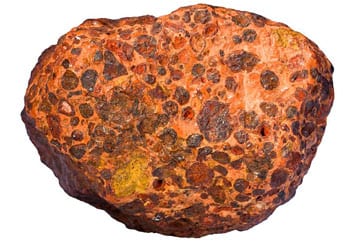భాషా ఎంచుకోండి:
Aluminum is the most common metal element found on Earth, totaling about 8% భూమి యొక్క క్రస్ట్. అయితే, aluminum as an element is reactive and therefore does not occur naturally – it needs to be refined to produce aluminum metal. అల్యూమినియం రిఫైనింగ్ కొరకు ప్రాథమిక ప్రారంభ పదార్థం బాక్సైట్, అల్యూమినియం యొక్క ప్రపంచంలోని ప్రధాన వాణిజ్య వనరు. Bauxite is a sedimentary rock, and consists mostly of the aluminium minerals gibbsite (అల్(OH)3), బోహ్మైట్ (γ-AlO(OH)) మరియు డయాస్పోర్ (α-AlO(OH)), and is usually mixed with the two iron oxides goethite and hematite, the aluminium clay mineral kaolinite and small amounts of anatase (TiO2) and/or ilmenite (FeTiO3).

బాక్సైట్ నిక్షేపాలు ప్రపంచవ్యాప్తంగా వ్యాప్తి చెందాయి, ఎక్కువగా ఉష్ణమండల లేదా ఉపఉష్ణమండల ప్రాంతాలలో సంభవిస్తుంది. Although proven reserves of bauxite are expected to last for many years, ఆర్థికంగా అందుబాటు చేసుకోగల నిల్వల నాణ్యత తగ్గుతోంది. రిఫైనర్ ల కొరకు, who are in the business of bauxite processing to make alumina, మరియు చివరికి అల్యూమినియం మెటల్, ఇది ఆర్థిక మరియు పర్యావరణ ప్రభావాలతో ఒక సవాలు.
The process to refine metallurgical bauxite into alumina involves the following inputs:
The following outputs are generated:

The most widely used chemical process of refining bauxite into alumina, the Bayer process, involves dissolving the Al2O3 out of the bauxite rock with caustic soda (నావోహ్) at elevated temperature and pressure. The Al2O3 fraction of the bauxite is dissolved into solution, to later be precipitated out as alumina. అయితే, a high-grade bauxite contains up to 60% Al2O3, and many operating bauxite deposits are well below this, అప్పుడప్పుడు అంత తక్కువగా 30-40% Al2O3. Because the desired product is a high purity Al2O3, బాక్సైట్ లోని మిగిలిన ఆక్సైడ్ లు (Fe2O3, SiO2, TiO2, Organic material) are separated from the Al2O3 and rejected as alumina refinery resides (ఎ.ఆర్.ఆర్.) or red mud. సాధారణంగా, తక్కువ నాణ్యత కలిగిన బాక్సైట్ (ie lower Al2O3 content) the more red mud is generated per ton of alumina product. అదనంగా, even some Al2O3 bearing minerals, ముఖ్యంగా కయోలినైట్, produce un-desirable side reactions during the refining process and lead to an increase in red mud generation, అలాగే ఖరీదైన కాస్టిక్ సోడా కెమికల్ ను కోల్పోవడం, బాక్సైట్ రిఫైనింగ్ ప్రక్రియలో ఒక పెద్ద వేరియబుల్ ఖర్చు.
ఎరుపు బురద లేదా ARR అల్యూమినియం పరిశ్రమకు పెద్ద మరియు కొనసాగుతున్న సవాలుకు ప్రాతినిధ్యం వహిస్తుంది. ఎర్ర బురదలో రిఫైనింగ్ ప్రక్రియ నుంచి మిగిలిపోయిన గణనీయమైన అవశేష కాస్టిక్ కెమికల్ ఉంటుంది., మరియు అత్యంత క్షారాకారం, తరచుగా ఒక pg తో 10 - 13. It is generated in large volumes worldwide – according to the USGS, అంచనా ప్రకారం ప్రపంచ అల్యూమినా ఉత్పత్తి 121 మిలియన్ టన్నుల 2016. This likely resulted in more than 150 ఇదే కాలంలో మిలియన్ టన్నుల ఎర్ర బురద ఉత్పత్తి అవుతుంది. పరిశోధన కొనసాగుతున్నప్పటికీ, ఎరుపు బురద ప్రస్తుతం ప్రయోజనకరమైన తిరిగి ఉపయోగించడానికి వాణిజ్యపరంగా కొన్ని ఆచరణీయ మార్గాలను కలిగి ఉంది. ప్రపంచవ్యాప్తంగా చాలా తక్కువ ఎర్ర బురద ప్రయోజనకరంగా తిరిగి ఉపయోగించబడుతుంది అని అంచనా వేయబడింది. Instead the red mud is pumped from the alumina refinery into storage impoundments or landfills, అక్కడ నిల్వ చేసి, పెద్ద ఖర్చుతో పర్యవేక్షిస్తాము.
ఖరీదైన కాస్టిక్ సోడా కోల్పోవడం (నావోహ్) and the generation of red mud are both related to the quality of the bauxite used in the refining process. సాధారణంగా, the lower the Al2O3 content of the bauxite, ఎర్రబురద యొక్క ఘనపరిమాణం ఎంత ఎక్కువగా జనరేట్ అవుతుంది, as the non-Al2O3 phases are rejected as red mud. అదనంగా, the higher the kaolinite or reactive silica content of the bauxite, మరింత ఎర్రబురద ఉత్పన్నం అవుతుంది. The reactive silica content not only increases the volume of red mud, but also consumes caustic soda reagent and reduces the yield of Al2O3 recovered from the bauxite. అందువలన, there is both an economic and environmental argument to be made for improving the quality of bauxite prior to refining.
ఎస్ టిఇటి పొడి వేర్పాటు ప్రక్రియ బాక్సైట్ ఉత్పత్తిదారులు లేదా బాక్సైట్ రిఫైనర్లకు నాణ్యతను మెరుగుపరచడానికి బాక్సైట్ ధాతువుయొక్క ప్రీ-బేయర్-ప్రాసెస్ అప్ గ్రేడింగ్ చేయడానికి అవకాశాన్ని అందిస్తుంది. ఈ విధానం వల్ల అనేక ప్రయోజనాలున్నాయి:
సారాంశంలో, STET సెపరేటర్ తో డ్రై ప్రాసెసింగ్ బాక్సైట్ ఉత్పత్తిదారులు మరియు రిఫైనరీలకు విలువను సృష్టించే అవకాశాలను అందిస్తుంది. శుద్ధి చేయడానికి ముందు బాక్సైట్ ను ప్రీ ప్రాసెసింగ్ చేయడం వల్ల రసాయన ఖర్చులు తగ్గుతాయి., ఉత్పత్తి చేయబడ్డ ఎర్రమట్టి యొక్క ఘనపరిమాణాన్ని తగ్గించండి మరియు ప్రాసెస్ కలతలను తగ్గించండి..
ప్రస్తావనలు: